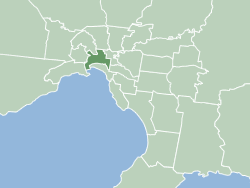City of Melbourne
|
City of Melbourne Victoria |
|||||||||||||
|---|---|---|---|---|---|---|---|---|---|---|---|---|---|

Aerial view of the Melbourne skyline
|
|||||||||||||

Location in Greater Melbourne
|
|||||||||||||
| Population | 127,742 (2015) | ||||||||||||
| • Density | 3,529/km2 (9,140/sq mi) | ||||||||||||
| Established | 1842 | ||||||||||||
| Area | 36.2 km2 (14.0 sq mi) | ||||||||||||
| Lord Mayor | Robert Doyle | ||||||||||||
| Council seat | Melbourne City Centre | ||||||||||||
| Region | Central Melbourne | ||||||||||||
| County | Bourke | ||||||||||||
| State electorate(s) | |||||||||||||
| Federal Division(s) | |||||||||||||
 |
|||||||||||||
| Website | City of Melbourne | ||||||||||||
|
|||||||||||||
The City of Melbourne is a local government area in Victoria, Australia, located in the central city area of Melbourne. The city has an area of 36 square kilometres (14 sq mi) and has a population of 127,672. The city's motto is "Vires acquirit eundo" which means "She gathers strength as she goes."
The current Lord Mayor is Robert Doyle. The Melbourne City Council (MCC) holds office in Melbourne Town Hall.
Melbourne was founded in 1835, during the reign of King William IV, with the arrival of the schooner Enterprize near the present site of the Queen's Wharf, as a barely legal, speculative settlement that broke away from New South Wales. Unlike other Australian capital cities, Melbourne did not originate under official auspices, instead forming through the foresight of settlers from Tasmania.
Having been a province of New South Wales from its establishment in 1835, affairs of the settlement had been administered by the Parliament of New South Wales. With the growth of the settlement there had been an increasing demand by the inhabitants for greater autonomy over their own affairs. On 12 August 1842, Melbourne was incorporated as a "town" by Act 6 Victoria No. 7 of the Governor and Legislative Council of New South Wales.
The town of Melbourne was raised to the status of a city by Letters Patent of Queen Victoria dated 25 June 1847, five years after its incorporation as a town. The Letters Patent also constituted the Anglican Diocese of Melbourne and declared Melbourne a cathedral city. A motion was tabled at a meeting of the Town Council to alter the style and title of Melbourne from a town to a city, a draft Bill was approved and transmitted to the Government for introduction to the Legislature. On 3 August 1849, Act 13 Victoria No. 14 was finally assented to as "An Act to effect a change in the Style and Title of the Corporation of Melbourne rendered necessary by the erection of the Town of Melbourne to a City".
...
Wikipedia
